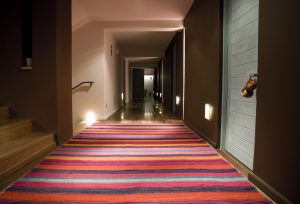
A carpet is a textile floor covering that typically is made in widths of four meters or more. Carpets can be used for a variety of purposes. They can add safety and comfort, as well as beauty. In addition, they are a lot easier to clean than real wooden floors. However, they do require weekly vacuuming, and annual deep cleaning.
There are a number of different kinds of fibers for a carpet. The most common are wool and synthetic fibers. These are both very strong, but they are also very expensive. Some people choose to use polypropylene, which is less expensive but is less resistant to abrasion. Polypropylene is also naturally stain-resistant.
Carpets have been around for hundreds of years, but they became popular only in the 19th century. Traditionally, they were woven from wool. Today, most carpets are manufactured from a mix of wool and synthetic fibers. Both fibers have been well accepted for their color clarity and their ability to resist staining.
Carpets are created by three steps. The first step is called tufting. Tufting is similar to sewing, with a tufting machine pulling the yarn through the backing.
The next step is dyeing. Before the yarn is tufted, it is pre-dyed to create the desired shade. Polyester is a good choice for these dyeing processes as it has good stain and fade resistance. Acrylic has been very popular in high-pile styles.
Next, a secondary backing is attached. This secondary backing is often a woven or synthetic polypropylene. It is then covered with a coat of latex.
The final stage of carpet manufacturing is shearing. This process is done to remove loose ends and to define the tip of the yarn. Antron has special soil-hiding characteristics.
To achieve the appropriate pile height, a looper pulls the yarn. When the proper height is reached, the looper cuts it off at the top. This type of pile is more durable than the cut pile. Also, it creates a soft texture.
The pattern can be directly transferred from the weaver, or it can be transferred indirectly from a pattern drawn on paper. There are many different techniques to transfer design, but the most common is through cross stitch. Embroidery is another technique. Many renowned embroiderers, such as Mary, Queen of Scots, are known to have an affinity for this craft.
Carpets can be manufactured in a wide variety of patterns. They can be a neutral foundation, or they can be the focal point of the room with bold colors and interesting textures. Each type of carpet is manufactured in slightly different ways.
The most important factors to consider when choosing a carpet are durability, cost, and style. You’ll need to make sure that it will match the rest of your home. If you are planning to purchase a new carpet, you’ll want to consider the amount of traffic it will receive. You can get more durable carpets if you are going to place them in high-traffic areas, but you may want to avoid carpets that are too low-density.
